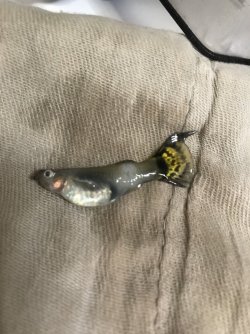shaziasadiqah
Fish Fanatic
This is a female guppy that my husband have in his 25gal fry tank.
she got this weird white spot on her body near the tail about 2 days ago and then i start anti fungal medication, do a 20% water change everyday and put airstone to give more oxygen.
but this morning i saw her dead laying on the substrate. When i pick her up i see her gils kinda peach in color and she was already stiff.
i really don’t know what kind of disease it is, i thought it is fungal infection because about a month ago my corydoras got it too and i treat with the same medication and the cory survive and perfectly healthy now.
do the fry and the other 2 females need treatment, too? What kind of meds i need?
by the way i dose only half with the angifungal medication because i’m worry if i dose too much or even the normal dosage it will hurt the fry, we got 50 fry more or less in that 25gal with 2 females.
please help. Thank you very much
she got this weird white spot on her body near the tail about 2 days ago and then i start anti fungal medication, do a 20% water change everyday and put airstone to give more oxygen.
but this morning i saw her dead laying on the substrate. When i pick her up i see her gils kinda peach in color and she was already stiff.
i really don’t know what kind of disease it is, i thought it is fungal infection because about a month ago my corydoras got it too and i treat with the same medication and the cory survive and perfectly healthy now.
do the fry and the other 2 females need treatment, too? What kind of meds i need?
by the way i dose only half with the angifungal medication because i’m worry if i dose too much or even the normal dosage it will hurt the fry, we got 50 fry more or less in that 25gal with 2 females.
please help. Thank you very much


